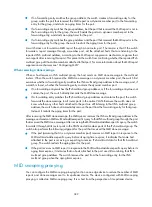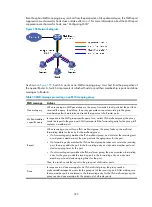
401
Configuring an IPv6 multicast group filter on a port
Step Command
Remarks
1.
Enter system view.
system-view
N/A
2.
Enter Layer 2 Ethernet
interface view or Layer 2
aggregate interface view or
enter port group view.
•
Enter Layer 2 Ethernet interface
view or Layer 2 aggregate
interface view:
interface
interface-type
interface-number
•
Enter port group view:
port-group
manual
port-group-name
Use either method.
3.
Configure an IPv6 multicast
group filter.
mld-snooping group-policy
acl6-number
[
vlan
vlan-list
]
By default, no IPv6 group filter is
configured for the port, and the
hosts on the port can join any valid
IPv6 multicast group.
Configuring IPv6 multicast source port filtering
When the IPv6 multicast source port filtering feature is enabled on a port, the port can only connect to
IPv6 multicast receivers rather than multicast sources. The reason is that the port denies all IPv6 multicast
data packets but it permits multicast protocol packets.
If this feature is disabled, the port can connect to both multicast sources and IPv6 multicast receivers.
The following matrix shows the feature and the MSR router compatibility:
Feature MSR900 MSR93X MSR20-1
X
MSR20 MSR30 MSR50 MSR1000
Multicast
source
port
filtering.
No. No. No. No.
Yes.
Supported
by the MIM
and XMIM
modules.
Yes.
Supported
by the FIC
modules.
No.
Configuring IPv6 multicast source port filtering globally
Step Command
Remarks
1.
Enter system view.
system-view
N/A
2.
Enter MLD-snooping view.
mld-snooping
N/A
3.
Enable IPv6 multicast source
port filtering.
source-deny
port
interface-list
Disabled by default.
Configuring IPv6 multicast source port filtering on a port
Step Command
Remarks
1.
Enter system view.
system-view
N/A
















































